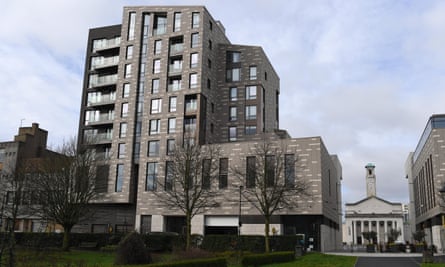Southampton’s new culture palace squats on the town square like a particularly lacklustre block of flats, clad in grey and beige tiles. Studio 144, the city’s £30m arts venue, provides a new well-equipped auditorium for Nuffield Southampton Theatres and an airy home for the university’s John Hansard Gallery, as well as a base for the City Eye film charity.
But you’d be hard-pressed to realise this as you approach the building. A pair of huge beige bookends face each other across an alley on one side of the square, looking like the entrance to a cut-price dictator’s palace. The five-storey high inverted L-shapes frame tinted glass walls, forming a momentous portal leading to a park beyond. Where you might expect to find this publicly funded arts beacon celebrating its presence on its frontage on Guildhall Square, instead you are greeted with a Nando’s, Costa and Gourmet Burger Kitchen. The theatre is up four flights of stairs, while the listed Victorian park behind, meanwhile, is treated to a parade of service entrances and ventilation grilles. How could £20m of council money, £8.6m of Arts Council England grants and a chunk from the University of Southampton have led to this?

Plans for the site date back to the early 2000s, when the Raven Group proposed an ambitious “city gateway” in the form of a pair of 20-storey towers whose 300 luxury flats would help to pay for an arts complex below. Southampton council was awed by the bold vision, hoping it would lead to a necklace of tall buildings around the green space, like New York’s Central Park. Raven hit financial difficulties, and the project was taken on by City Lofts, before they were crushed in turn by the 2008 global financial meltdown. By now the site, which was home to a dingy postwar department store, Tyrell & Green, had been vacant and boarded up for eight years, and the council had committed £1.5m to demolishing the building without having a development partner on board. Spotting a long-term opportunity where no others dared to tread, Grosvenor, the Duke of Westminter’s £12bn property firm, agreed to take on the site and set about making the project stack up.
“They knew that their commercial value would come from the ground floor,” says Adam West, partner of CZWG Architects, who designed the new building’s shell, “so we had to raise the arts venues up to the first and second floor.” He says the towers of flats were no longer viable, so the two posts of the original gateway design became one, stepped and sculpted into a lumpen mountain on the southern side of the site, while the glazed fly-tower of the theatre now pokes up on the northern side, as if trying in vain to balance the composition. The grand limestone portals are a residue of the once-symmetrical plan, marking the lobbies of the new gallery on the right and the theatre to the left, but their full-height tinted glazing gives them the look of a corporate office complex, while a dotted diamond pattern runs across the rest of the greige tiling in a strained attempt at whimsy.
The contractor-led aesthetic continues inside, with lino floors, suspended ceilings and clumsy glass balustrades, lending the whole place a cheap, institutional air. In places the deep-serviced ceilings crash into the windows, radiator pipes are left exposed and wiring is tacked to the wall in bulky tracking boxes. Architect Glenn Howells was responsible for the interiors, appointed by the previous developer long before CZWG got involved, and the result is the compromised product of decisions falling between the two stools. “We didn’t know what was happening on the inside while we were designing the outside,” says West. “It was almost like a refurbishment project, with us working for Grosvenor, while they were doing the fit-out for the council.”
Further evidence of the consequences of the public sector’s reliance on profit-driven private sector firms is to be found nearby. Across the square from the new building stands the handsome classical portico of the Guildhall, built in the 1930s as the city’s town hall, but now the home of the O2 music venue. Its civic functions have been moved to a bulky glass box on the southern side of the square, designed and built by Capita, the outsourcing giant from which the council procures everything from customer services to IT, tax and benefits. From their low-ceilinged offices, the Capita-council employees can look out on to the city’s new flagship development by Grosvenor, inside which the arts complex is housed, wrapped with a money-making skin of restaurants and apartments. As a diagram of public funds being swallowed by private interests, this little slice of city couldn’t be more explicit.

“The challenge is always how to pay for cultural uses in a viability sense,” says Mike Harris, the council’s director of growth, who heads up a team charged with delivering a suite of “very important projects”, from housing to malls, outlined in the city’s masterplan that was launched in 2012 with a target of attracting £3bn of investment by 2032. “Southampton had stagnated for so long. We weren’t on the radar of many investors wanting to contribute to UK plc, ” he says, adding proudly that he now attends MIPIM, the annual champagne-soaked jamboree in Cannes, where council officers attempt to broker deals with investors. “We don’t see our competitor as Portsmouth anymore. Why not Bilbao?”

Comments (…)
Sign in or create your Guardian account to join the discussion